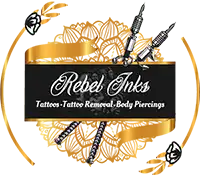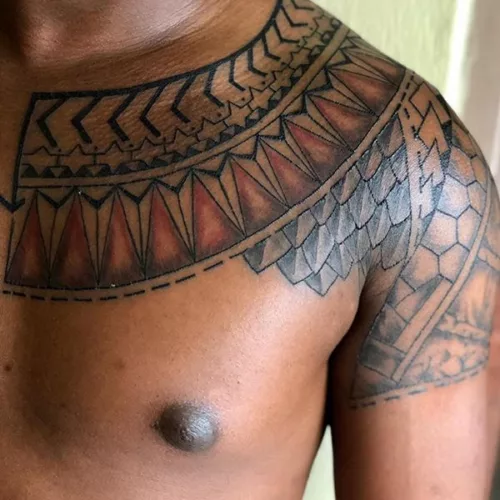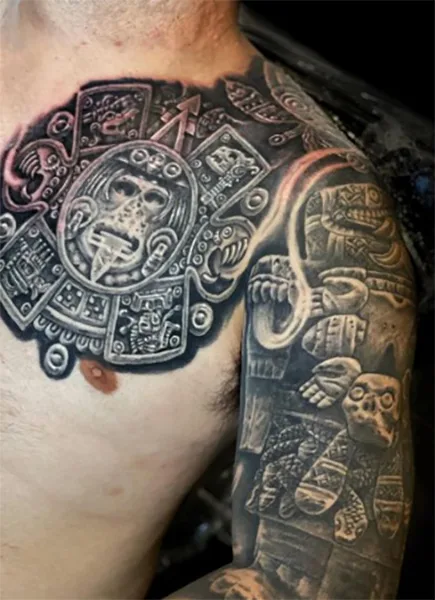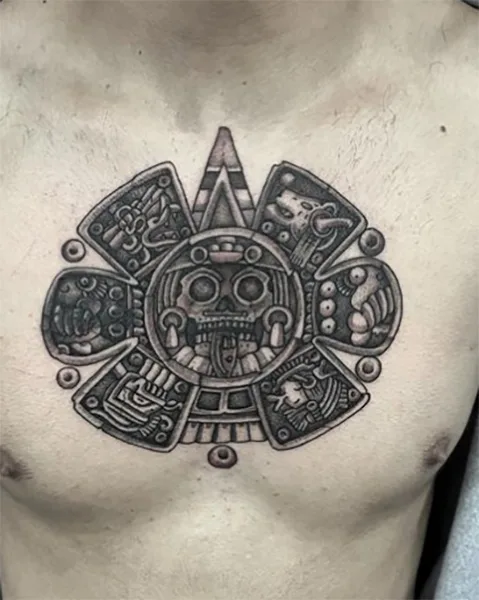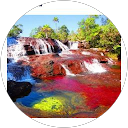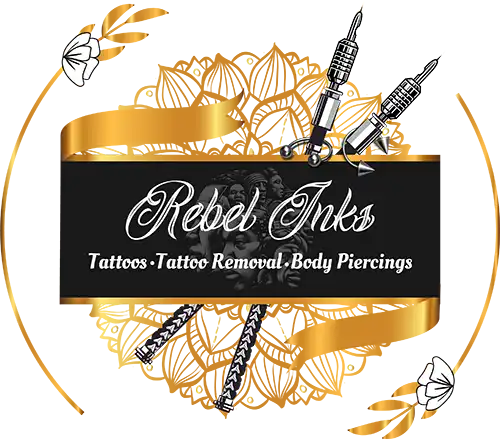Tribal Tattoos in Nairobi, Kenya
(Design Techniques, Best Placements, and FAQ’s)
Tribal tattoos refer to a style of tattooing that originated from various indigenous cultures around the world. These tattoos are characterized by bold, black lines and geometric patterns that often form abstract or symmetrical designs. Tribal tattoos have a long history and have been practiced by different tribes in places such as Polynesia, Native America, Africa, and Southeast Asia.
Tribal Tattoos
In traditional tribal cultures, tattoos held significant cultural and spiritual meaning. They were used to represent a person’s status, achievements, or affiliation with a particular tribe or community. The designs often symbolized important aspects of tribal life, such as ancestry, spirituality, protection, and personal identity.
Polynesian tribal tattoos, for example, are renowned for their intricate patterns and symbolism. They often incorporate elements like ocean waves, sun, turtles, and other marine creatures, reflecting the deep connection of Polynesian people with the sea. Maori tattoos, from the indigenous people of New Zealand, feature curving and spiraling patterns called “koru” that represent life, growth, and regeneration.
Over time, tribal tattoos have gained popularity outside their original cultural contexts and have been adapted and modified to suit contemporary tattoo styles. Many people today choose tribal tattoos for their aesthetic appeal, without necessarily ascribing to the specific cultural meanings behind the designs.
It’s important to note that while tribal tattoos can be visually striking, it’s crucial to respect the cultural significance behind them. If you’re considering getting a tribal tattoo, it’s advisable to research the cultural context and meanings associated with the specific style you’re interested in. Consulting with a professional tattoo artist who specializes in tribal designs can also help ensure that the tattoo is executed accurately and respectfully.
Tribal Tattoos Design Techniques
Tribal tattoos encompass a wide range of styles and techniques due to their cultural diversity and historical significance. Here are some techniques commonly associated with tribal tattooing:
African
African tribal tattoos encompass a wide range of diverse and culturally rich body art traditions practiced by various ethnic groups across the African continent. These tattoos hold deep cultural, spiritual, and symbolic significance within African societies, and the specific designs and meanings can vary greatly depending on the region and tribe.
African tribal tattoos often draw inspiration from the natural world, ancestral heritage, mythological figures, and spiritual beliefs. They can feature bold patterns, abstract designs, and representations of animals, plants, and sacred symbols.
- Berber Tattoos: Berber tribes in North Africa, such as the Amazigh people, have a long history of tattooing. Their tattoos often incorporate geometric patterns, symbols of protection, and cultural identity markers.
- Ndebele Tattoos: The Ndebele people of South Africa and Zimbabwe are known for their elaborate and colorful geometric tattoos. These tattoos are often worn by women and serve as a form of cultural expression and identity.
- Maasai Tattoos: The Maasai tribe of East Africa traditionally practice scarification, which involves cutting the skin to create raised patterns. These scars serve as markers of beauty, bravery, and social status within the community.
- Yoruba Tattoos: The Yoruba people of Nigeria have a rich tattooing tradition called “ileke” or “pélé.” These tattoos feature intricate designs that often represent deities, ancestors, or personal achievements.
- Ethiopian Tattoos: The Oromo people of Ethiopia have a tradition of tattooing their faces with fine lines and dots. These tattoos are seen as a symbol of beauty and cultural identity.
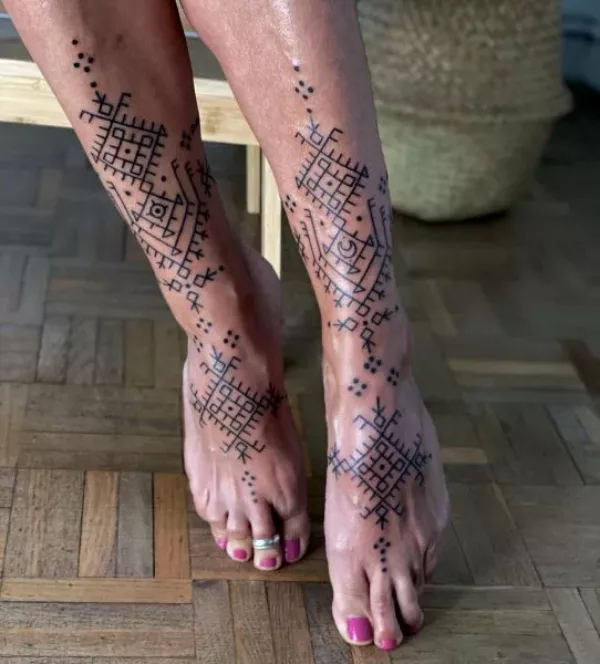
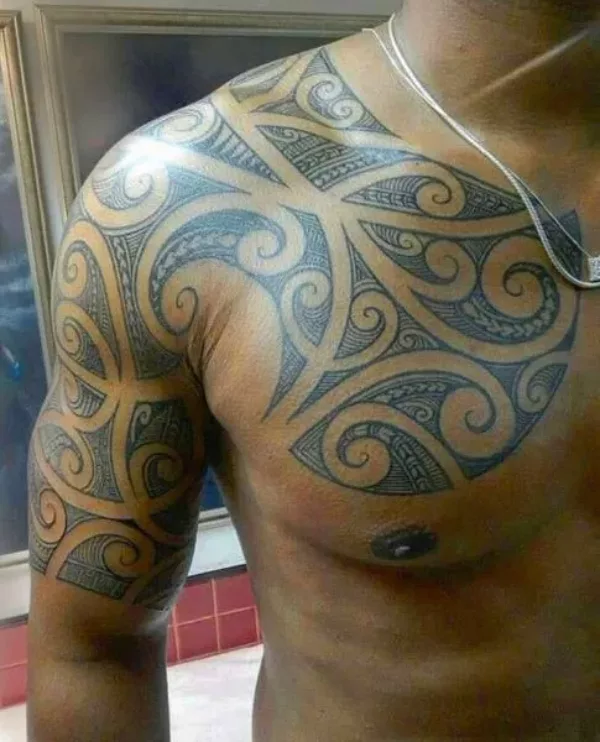
Māori/ Tā moko
Māori tribal tattoos, also known as tā moko, are a traditional form of body art practiced by the Māori people of New Zealand.
Tā moko involves the process of carving or etching the skin using chisels and ink pigment. It is different from other forms of tattooing as it is not applied using a needle and does not penetrate the skin as deeply. Tā moko designs are typically done on the face (moko kauae) for women and on the face and other parts of the body for men.
Each tā moko design is unique and carries personal and ancestral significance. The patterns and motifs used in tā moko often represent the wearer’s lineage, social status, achievements, and connection to their ancestors. They can also symbolize important aspects of Māori cosmology and spiritual beliefs.
Samoan/ Tatau
Samoan tribal tattoos, known as tatau, are an ancient form of body art practiced by the Samoan people of Polynesia. Similar to Māori tā moko, Samoan tatau holds deep cultural and spiritual significance within Samoan society.
Tatau is a traditional art form that involves using handmade tools to apply ink pigment into the skin. The process is done by tapping the tools, which consist of sharpened boar’s teeth or shark’s teeth attached to a bone or wooden handle, into the skin. This method, known as “tapping” or “hand-tapping,” requires great skill and is a testament to the craftsmanship of the tattoo artist.
Samoan tattoos are traditionally applied to various parts of the body, including the back, chest, arms, and legs. These tattoos often consist of intricate patterns and geometric designs, incorporating elements such as lines, curves, and repetitive motifs. The placement, size, and design of the tatau can convey different meanings and reflect the wearer’s social status, achievements, and personal history.
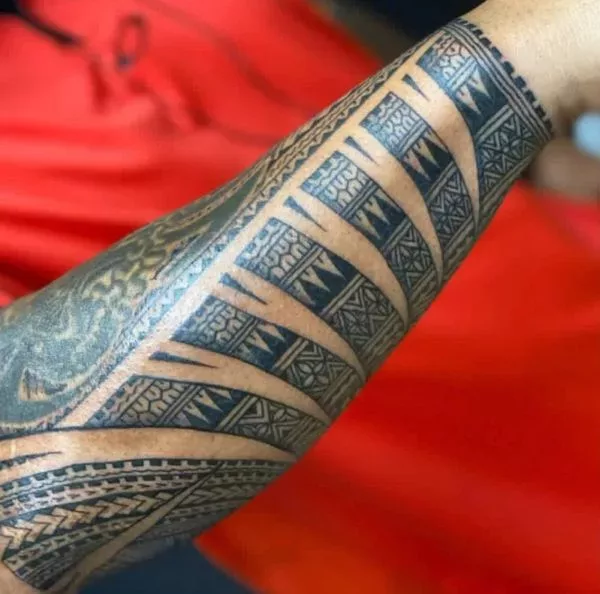


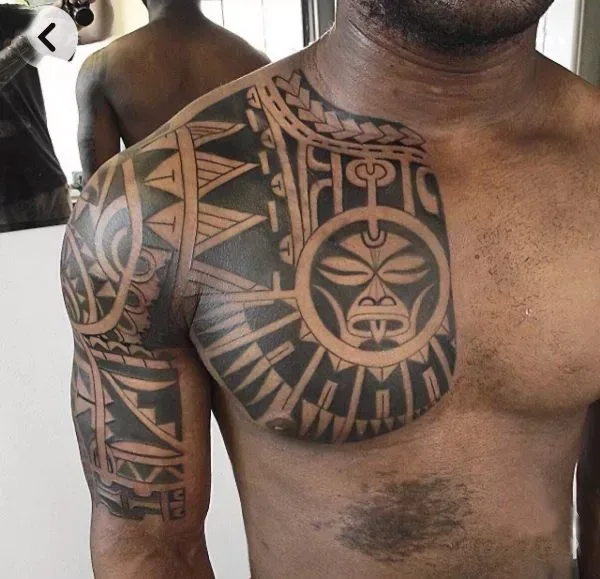


Marquesan/ Enata
Marquesan tribal tattoos, also known as “enata,” are a traditional form of body art practiced by the Marquesan people of the Marquesas Islands in French Polynesia. Marquesan tattoos are known for their intricate and bold designs, often characterized by geometric patterns, flowing lines, and stylized human and animal figures.
Marquesan tattoos have a long history and hold significant cultural and spiritual meaning within Marquesan society. They serve as a visual representation of the wearer’s identity, social status, and personal journey. These tattoos are deeply connected to the rich mythology, history, and traditions of the Marquesan people.
The motifs and symbols used in Marquesan tattoos often vary based on the wearer’s gender, lineage, and personal preferences. The designs can incorporate elements such as turtles, birds, lizards, rays, and other animals, as well as patterns inspired by nature, including waves, leaves, and shells. These symbols are often arranged in symmetrical patterns and placed strategically on the body, such as the chest, arms, back, and thighs.
Hawaiian/ Kākau
Hawaiian tribal tattoos, known as “kākau” in the Hawaiian language, are a traditional form of body art that originated in the Hawaiian Islands. These tattoos are deeply rooted in Hawaiian culture and hold significant cultural and spiritual meaning.
Hawaiian tattoos traditionally feature bold, black designs with geometric patterns and nature-inspired elements. They often incorporate symbols such as waves, sharks, turtles, fish, flowers (such as hibiscus), and other elements found in the Hawaiian natural environment. Each symbol carries its own significance and can represent qualities like strength, protection, guidance, or connection to the land and sea.
In Hawaiian culture, tattoos were not only a form of artistic expression but also served as a means of storytelling and preserving cultural heritage. They were used to convey a person’s lineage, social status, and personal achievements. Tattoos were also believed to offer spiritual protection and connect the wearer to their ancestors.
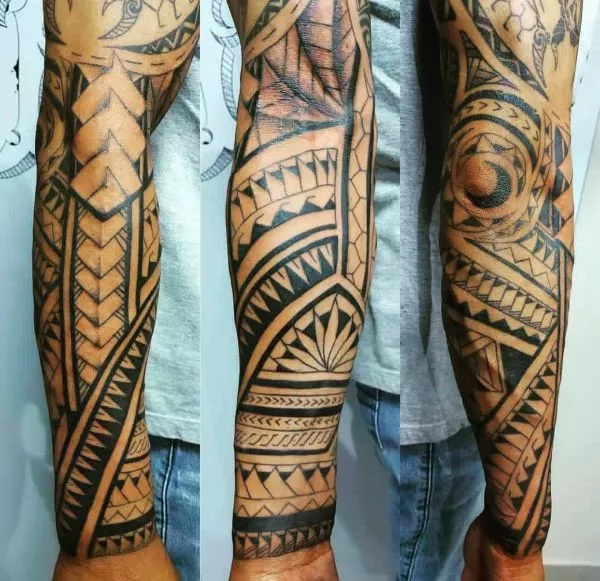


Mayan
Mayan tribal tattoos, also known as Mayan glyphs or symbols, are inspired by the ancient Mayan civilization that thrived in Mesoamerica, particularly in present-day Mexico, Guatemala, Belize, Honduras, and El Salvador. Mayan tattoos draw upon the rich cultural and artistic traditions of the Mayan people.
Mayan tattoos often incorporate intricate geometric patterns, stylized animals, and symbolic glyphs or hieroglyphics. These glyphs represent various concepts, including gods, celestial bodies, natural elements, and important cultural or historical events. Each glyph carries its own meaning and can be combined to tell a specific story or convey a particular message.
The designs of Mayan tribal tattoos can vary widely, depending on the individual’s preferences, cultural connection, and personal interpretation of the symbols. They may be applied to different parts of the body, such as the arms, chest, back, or legs.
It’s important to note that tribal tattoos encompass a wide range of styles and techniques due to the cultural diversity associated with indigenous tribes worldwide. Different regions and cultures have their own unique approaches to tattooing, and it’s essential to research and respect the specific techniques and meanings associated with the tribal style you are interested in. Consulting with a skilled and knowledgeable tattoo artist who specializes in tribal tattoos can help ensure an accurate and respectful representation of the style you desire.
Schedule Appointment
Tribal Tattoos
Where do Tribal Tattoos look best
The placement of tribal tattoos largely depends on personal preference and the size and design of the tattoo. Here are some common areas where tribal tattoos often look visually appealing:
- Arms: Tribal tattoos are commonly seen on the upper arms, lower arms, or even wrapping around the entire arm. The muscular contours of the arms can enhance the bold lines and geometric patterns of tribal designs.
- Shoulders: Tribal tattoos on the shoulders can create a strong and impactful look. They can be extended onto the upper back or chest for a larger and more elaborate design.
- Chest: Tribal tattoos on the chest can be visually striking, especially if you want a larger and more intricate design that covers a significant portion of the chest area.
- Back: The back offers a large canvas for tribal tattoos, allowing for expansive and elaborate designs. Full back pieces or upper back tattoos that extend to the shoulders and neck can be particularly impactful.
- Legs: Tribal tattoos on the thighs, calves, or even around the ankles can create a visually appealing and balanced look. The shape and curves of the legs can complement the lines and patterns of tribal designs.
- Torso/Sides: Tribal tattoos on the sides of the torso, also known as the rib cage area, can be visually captivating. They can be designed to follow the natural contours of the body or incorporated into other tattoo elements on the front or back.
Ultimately, the best placement for a tribal tattoo depends on factors such as the size and complexity of the design, your personal style, and your comfort level. It’s important to consider how the tattoo will interact with your body’s natural shape and movement. Consulting with a skilled tattoo artist can help you determine the most suitable placement for your desired tribal tattoo.
Factors that you should consider when getting a Tribal Tattoos
When getting a tribal tattoo, it’s important to consider several factors to ensure that you make an informed decision and end up with a tattoo that you’ll be happy with for years to come. Here are some key factors to consider:
- Cultural and Symbolic Meaning: Tribal tattoos often have deep cultural and symbolic meanings associated with specific tribes or cultures. Research the origins and symbolism behind the tribal style you are interested in to understand its significance. Ensure that you approach the tattoo with respect and cultural sensitivity.
- Design and Style: Explore different tribal tattoo styles and designs to find the one that resonates with you. Consider whether you prefer bold, black designs or more intricate patterns. Decide if you want a specific tribal style, such as Polynesian, Maori, or Native American, or if you prefer a fusion of different tribal elements.
- Size and Placement: Think about the size and placement of your tattoo. Consider the body part you want to get tattooed and how the size of the design will work in that area. Take into account factors like visibility, how the tattoo will interact with your body’s natural contours, and if you plan to expand the tattoo in the future.
- Skilled Tattoo Artist: Find a skilled tattoo artist who specializes in tribal tattoos. Look for an artist who has experience and knowledge of the specific tribal style you desire. Review their portfolio and ensure their artistic style aligns with your vision. Consult with the artist to discuss your ideas and ask for their input.
- Aftercare and Long-Term Maintenance: Consider the aftercare and long-term maintenance of your tattoo. Tribal tattoos, like any other tattoos, require proper care to ensure proper healing and to maintain the longevity and appearance of the design. Follow the aftercare instructions provided by your tattoo artist and be prepared to commit to the necessary care and maintenance routine.
- Personal Connection: Choose a tribal design that holds personal significance for you. While it’s important to respect the cultural origins of tribal tattoos, finding a design that resonates with your own story, values, or heritage can make the tattoo even more meaningful to you.
Remember, getting a tattoo is a personal decision, and taking the time to consider these factors will help you make an informed choice. At Rebel Inks Body Piercings and Tattoo Parlour we can provide guidance, answer your questions, and ensure that your tribal tattoo is executed accurately and respectfully.
Tribal Tattoos frequently asked questions
Here are some frequently asked questions about tribal tattoos:
What is the meaning behind tribal tattoos?
The meaning of tribal tattoos can vary depending on the culture and region they originate from. In traditional tribal cultures, tattoos often held deep cultural, spiritual, and personal significance. They could represent a person’s lineage, achievements, social status, protection, or connection to a particular tribe or community. It’s important to research and understand the specific cultural context and meanings associated with the tribal tattoo style you’re interested in.
Can I get a tribal tattoo even if I don’t belong to that tribe or culture?
Yes, you can choose to get a tribal tattoo even if you don’t belong to the specific tribe or culture associated with it. However, it’s crucial to approach it with respect and cultural sensitivity. Understanding the history, symbolism, and cultural significance behind the design can help ensure you appreciate and represent the style appropriately. It’s advisable to consult with a knowledgeable tattoo artist who specializes in tribal tattoos to ensure your design is executed respectfully.
Can tribal tattoos be customized or modified?
Yes, tribal tattoos can be customized or modified to suit your personal preferences or to incorporate meaningful elements. Many people choose to incorporate personal symbols, names, or other design elements into their tribal tattoos to make them more unique and personally significant. It’s important to discuss your ideas with a skilled tattoo artist who can work with you to create a design that respects the traditional tribal style while reflecting your individuality.
Do tribal tattoos have to be black and bold?
While traditional tribal tattoos often feature bold black ink, tribal-inspired designs can be adapted to incorporate other colors and shading techniques if desired. Modern interpretations of tribal tattoos may use a wider color palette or incorporate shading and gradients to add depth and dimension to the design. It ultimately depends on your personal preference and the style you’re aiming for. Discussing your ideas with a tattoo artist can help determine the best approach for your desired outcome.
Do tribal tattoos have any specific placement considerations?
There are no strict placement rules for tribal tattoos, but historically, certain cultures and regions had specific placement traditions. For example, Polynesian tribal tattoos were commonly found on the arms, legs, chest, and back. However, in modern times, tribal tattoos can be placed anywhere on the body based on personal preference and the design itself. It’s important to consider factors such as the size of the tattoo, visibility, and your own comfort when deciding on the placement.
Get In Touch
For more information on the list above and any other special services,please call or come in for free consultation
Testimonials
OUR LOCATION
Areas We Serve
NAIROBI
KIAMBU
KAJIADO
MACHAKOS
